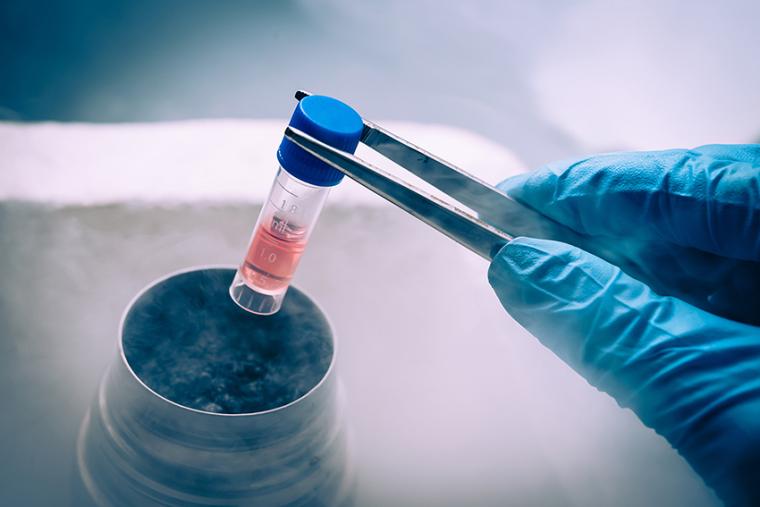
The University of Oklahoma has officially launched its new Bioprocessing Core Facility (OU BPCF)—a major investment in biotechnology research, hands-on education and regional economic development. Funded through a Build Back Better Regional Challenge (EDA) grant, which was secured in partnership with the Greater Oklahoma City Chamber—a key collaborator in advancing the proposal and aligning regional economic development priorities, the $4 million facility is already positioning OU as a leader in biomanufacturing education and innovation.
Located in the OKC Innovation District, the Bioprocessing Core Facility (BPCF) offers students, researchers and industry partners access to state-of-the-art biomanufacturing equipment, spanning from lab-scale to pilot-scale production. The facility enables everything from cell culture expansion to downstream protein purification, mirroring the full workflow used in pharmaceutical manufacturing and biotechnology development.
"Basically, what you're seeing here is a miniature version of an industrial biomanufacturing setup," said Dr. Farid Talebnia Rowshan, research assistant professor and director of the OU BPCF, during a recent tour. "We built this facility to bridge the gap between academic research and real-world industry needs."
Hands-on learning for future biotech professionals
One core focus of the facility is workforce development. OU’s two-year Bioprocessing Certificate Program gives students the opportunity to train across every stage of the biomanufacturing process, learning to grow cell cultures, operate bioreactors, monitor production quality and purify therapeutic proteins. Students gain experience with industry-standard systems—including high-tech bioreactors, chromatography systems and automated analytical tools—ensuring they are ready to enter the workforce immediately upon graduation.
Students in the program train with innovative biomanufacturing equipment found in top-tier pharmaceutical companies. The facility features two BioProfile FLEX2 systems—one integrated into an Ambr 250 High Throughput system and one stand-alone—allowing precise monitoring of cell cultures during production. The Ambr 250, capable of running twelve bioreactor experiments simultaneously, helps students and researchers scale up processes efficiently.
Additional analytical tools, such as the Maurice Capillary Electrophoresis Instrument and the Uncle Protein Stability Screening Platform, enable advanced testing of protein quality, purity and stability—skills critical for careers in the biotechnology industry.
"We teach them how to do things manually first, so they understand the science of it, and then they get experience with the advanced systems," said Dr. Achinta Bordoloi, research scientist at the facility. "That way, they can walk into industry ready to work with any setup."
The facility has already trained 64 students, with more enrolled in ongoing certificate programs and research internships. OU expects that number to grow significantly as more undergraduate students complete prerequisite coursework and enter the program.
A resource for startups and industry partners
“The Bioprocessing Core Facility is a critical link in Oklahoma’s bioscience infrastructure,” said Michelle Gregory, director of Life Science Oklahoma. “It’s the kind of investment that strengthens our regional capacity to innovate, attract industry and prepare talent for the future of biomanufacturing.”
For early-stage companies, access to BPCF represents a significant advantage: expensive pilot-scale equipment can often be a barrier to growth. OU’s facility lowers that barrier, giving companies the infrastructure they need to develop products without the overhead of building their own facilities.
The BPCF also supports research collaborations and is a key player in Life Sciences Oklahoma, building bridges between academia, startups and industry.
“The launch of the Bioprocessing Core Facility reflects the University of Oklahoma’s deep commitment to advancing biotechnology in our state and beyond. By fostering hands-on learning, supporting high-impact research and cultivating strategic partnerships with industry, this facility plays a vital role in shaping a competitive, innovative-driven workforce. It positions OU as a leader in biomanufacturing education while contributing meaningfully to regional economic development and scientific progress,” said John Klier, dean of the Gallogly College of Engineering at OU.
One of the facility’s standout features is its fully automated system, capable of running up to twelve bioreactor experiments simultaneously. This high-throughput setup drastically reduces the time needed to optimize processes, helping innovations move faster from research to real-world application.
In addition, there are plans to incorporate emerging technologies like artificial intelligence and data science into the workflow. Students and researchers are already collecting large datasets during bioreactor runs, with future efforts aiming to integrate predictive analytics to optimize production even further.
Collaboration across OU and beyond
The opening of the BPCF aligns with OU’s broader "One OU" strategic plan, aimed at fostering collaboration across its campuses and research centers. Leaders at the facility are already building relationships with other OU programs and external research partners, looking to create an integrated pipeline from early-stage discovery to scalable production.
“We want this to be a regional hub for innovation, talent and biotech industry growth,” Dr. Rowshan explained.
As Oklahoma’s biotech sector continues to expand, university leaders hope the BPCF will serve as a catalyst for new partnerships, job creation and technological breakthroughs.
Featured equipment at OU’s Bioprocessing Core Facility:
- BioProfile FLEX2 (Integrated into Ambr250 and Stand-Alone): Real-time monitoring of cell viability and metabolite concentrations.
- Ambr 250 High Throughput (12-way): Automated bioreactor system for parallel processing and optimization.
- Maurice Capillary Electrophoresis Instrument: High-resolution protein purity and characterization analysis.
- Uncle Protein Stability Screening Platform: Thermal and chemical stability testing for biopharmaceuticals.
